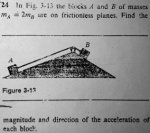Maksmaksmaks
New member
- Joined
- Sep 14, 2016
- Messages
- 6
Hello everyone. I came here for your help. I am very tired trying to figure out how to solve this problem. Please help me.
The problem: The Blocks A and B of masses mA=2mB are on frictionless planes. Find the magnitude and direction of the acceleration of each block.
Answer: aA=0.54m/s2down and aB=0.54m/s2up
Please help me and provide solution. So far I managed to get their masses.
W(weight) = m(mass)g(gravity)
mB = 2mg
= 2 (9.8 m/s2)
= 19.6 m/s2
The problem: The Blocks A and B of masses mA=2mB are on frictionless planes. Find the magnitude and direction of the acceleration of each block.
Answer: aA=0.54m/s2down and aB=0.54m/s2up
Please help me and provide solution. So far I managed to get their masses.
W(weight) = m(mass)g(gravity)
mB = 2mg
= 2 (9.8 m/s2)
= 19.6 m/s2
Last edited:


